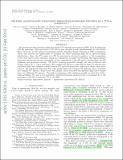THE FIRST MAXIMUM-LIGHT ULTRAVIOLET THROUGH NEAR-INFRARED SPECTRUM OF A TYPE Ia SUPERNOVA
Author(s)
Foley, Ryan J.; Kromer, Markus; Marion, G. Howie; Pignata, Giuliano; Stritzinger, Maximilian D.; Taubenberger, Stefan; Challis, Peter; Filippenko, Alexei V.; Hillebrandt, Wolfgang; Hsiao, Eric Y.; Kirshner, Robert P.; Li, Weidong; Morrell, Nidia I.; Röpke, Friedrich K.; Ciaraldi-Schoolmann, Franco; Seitenzahl, Ivo R.; Silverman, Jeffrey M.; Simcoe, Robert A.; Berta-Thompson, Zach; Ivarsen, Kevin M.; Newton, Elisabeth R.; Nysewander, Melissa C.; Reichart, Daniel E.; Folatelli, Gaston; ... Show more Show less
DownloadSimcoe_The first maximum.pdf (370.8Kb)
OPEN_ACCESS_POLICY
Open Access Policy
Creative Commons Attribution-Noncommercial-Share Alike
Terms of use
Metadata
Show full item recordAbstract
We present the first maximum-light ultraviolet (UV) through near-infrared (NIR) Type Ia supernova (SN Ia) spectrum. This spectrum of SN 2011iv was obtained nearly simultaneously by the Hubble Space Telescope at UV/optical wavelengths and the Magellan Baade telescope at NIR wavelengths. These data provide the opportunity to examine the entire maximum-light SN Ia spectral energy distribution. Since the UV region of an SN Ia spectrum is extremely sensitive to the composition of the outer layers of the explosion, which are transparent at longer wavelengths, this unprecedented spectrum can provide strong constraints on the composition of the SN ejecta, and similarly the SN explosion and progenitor system. SN 2011iv is spectroscopically normal, but has a relatively fast decline (Δm [subscript 15](B) = 1.69 ± 0.05 mag). We compare SN 2011iv to other SNe Ia with UV spectra near maximum light and examine trends between UV spectral properties, light-curve shape, and ejecta velocity. We tentatively find that SNe with similar light-curve shapes but different ejecta velocities have similar UV spectra, while those with similar ejecta velocities but different light-curve shapes have very different UV spectra. Through a comparison with explosion models, we find that both a solar-metallicity W7 and a zero-metallicity delayed-detonation model provide a reasonable fit to the spectrum of SN 2011iv from the UV to the NIR.
Date issued
2012-06Department
Massachusetts Institute of Technology. Department of Physics; MIT Kavli Institute for Astrophysics and Space ResearchJournal
The Astrophysical Journal. Letters
Publisher
IOP Publishing
Citation
Foley, Ryan J., Markus Kromer, G. Howie Marion, Giuliano Pignata, Maximilian D. Stritzinger, Stefan Taubenberger, Peter Challis, et al. “THE FIRST MAXIMUM-LIGHT ULTRAVIOLET THROUGH NEAR-INFRARED SPECTRUM OF A TYPE Ia SUPERNOVA” The Astrophysical Journal 753, no. 1 (June 13, 2012): L5.
Version: Original manuscript
ISSN
2041-8205
2041-8213